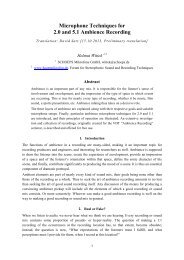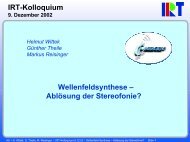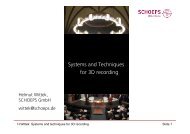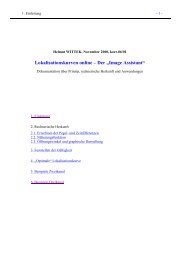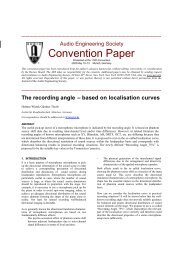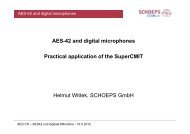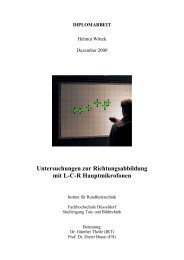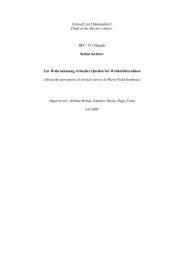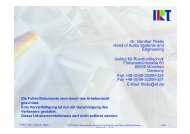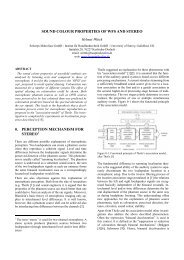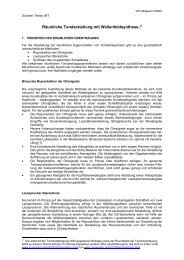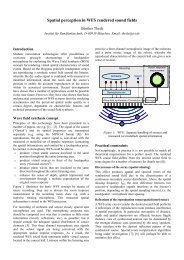on the localisation in the superimposed soundfield - Hauptmikrofon ...
on the localisation in the superimposed soundfield - Hauptmikrofon ...
on the localisation in the superimposed soundfield - Hauptmikrofon ...
Create successful ePaper yourself
Turn your PDF publications into a flip-book with our unique Google optimized e-Paper software.
16<br />
B5: Dichotic presentati<strong>on</strong> of <strong>the</strong> artificial head signals, which have been recorded<br />
without <strong>the</strong> p<strong>in</strong>nae of <strong>the</strong> artificial head<br />
B6: Dichotic presentati<strong>on</strong> of <strong>the</strong> microph<strong>on</strong>e signals, which have been recorded<br />
without <strong>the</strong> head and p<strong>in</strong>nae of <strong>the</strong> artificial head<br />
When presented over headph<strong>on</strong>es, <strong>the</strong> test signals A1 … A4 and B1 … B6 create<br />
more or less stable phantom sources. To give an example, depend<strong>in</strong>g <strong>on</strong> <strong>the</strong> accuracy<br />
of <strong>the</strong> record<strong>in</strong>g and playback stages, Signal A1 should produce an easily localisable<br />
phantom source, whilst Signal B2 will certa<strong>in</strong>ly result <strong>in</strong> a poor reproducti<strong>on</strong>. In order<br />
to be able to compare <strong>the</strong>se scenarios to <strong>the</strong> localisati<strong>on</strong> c<strong>on</strong>diti<strong>on</strong>s applicable to a real<br />
sound source, three o<strong>the</strong>r test signals are also <strong>in</strong>cluded:<br />
Group C:<br />
No phantom source situati<strong>on</strong>, but a loudspeaker positi<strong>on</strong>ed <strong>in</strong> <strong>the</strong> median plane. The<br />
follow<strong>in</strong>g reproducti<strong>on</strong> scenarios are chosen:<br />
C1: O<strong>the</strong>rwise as A1<br />
C2: Instead of <strong>the</strong> pivot<strong>in</strong>g movement, <strong>the</strong> artificial head is rotated by δ ± 30°<br />
C3: As C2, but diotic presentati<strong>on</strong> of <strong>on</strong>e artificial head signal<br />
Us<strong>in</strong>g headph<strong>on</strong>es, each test signal is presented to <strong>the</strong> subjects twice. For each<br />
presentati<strong>on</strong>, <strong>the</strong> auditory event (produced by <strong>the</strong> associated test signal) has to be<br />
evaluated <strong>in</strong> terms of <strong>on</strong>e attribute of detectability, i.e. <strong>the</strong> detectability of sound<br />
colour changes (Attribute Kl) or <strong>the</strong> detectability of directi<strong>on</strong>al changes (Attribute<br />
Ri). A 5-po<strong>in</strong>t rat<strong>in</strong>g scale is used:<br />
0: not detectable<br />
0.25: just about detectable<br />
0.5: detectable<br />
0.75: clearly detectable<br />
1: very clearly detectable<br />
Before each trial, <strong>the</strong> subjects are presented with a few test examples. This helps<br />
improve judgement c<strong>on</strong>sistency and prevents learn<strong>in</strong>g effects dur<strong>in</strong>g <strong>the</strong> actual<br />
listen<strong>in</strong>g test. Dur<strong>in</strong>g this tra<strong>in</strong><strong>in</strong>g phase, <strong>the</strong> subjects’ attenti<strong>on</strong> is drawn ei<strong>the</strong>r to<br />
Attribute Kl or Attribute Ri. For 11 participants this happens first for Kl, whilst 11<br />
o<strong>the</strong>r participants are asked to evaluate Ri first.<br />
Listen<strong>in</strong>g test results<br />
1. The relati<strong>on</strong>ship between <strong>the</strong> attributes Kl and Ri for <strong>the</strong> test signal groups A<br />
and B is evident from Figure 7. Each <strong>in</strong>cluded Kl/Ri-value c<strong>on</strong>stitutes <strong>the</strong><br />
arithmetic mean of <strong>the</strong> verdicts of 11 subjects for <strong>on</strong>e test signal (four mean



